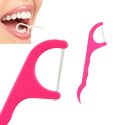
|

|

|

|

Mastering the Art of Flossing with Braces: A Step-by-Step Guide
If you’re a dental patient with braces, taking care of your oral hygiene might seem like an overwhelming chore. Brushing and flossing become more extensive and important tasks when it comes to making sure your teeth stay healthy while wearing braces.
Learning how to properly floss with braces can take some time, but don’t worry – this step-by-step guide will make the process much easier for you! Keep reading to discover all the tips and tricks that our team at XYZ Dental Clinic has put together in order to help you get the job done right.
Proper Tools for Flossing with Braces
When it comes to flossing with braces, having the right tools can make a significant difference in your oral hygiene routine. Here are some proper tools you should consider using for effective flossing with braces:
- Orthodontic Floss Threaders: Orthodontic floss threaders are small, flexible devices that help guide floss underneath the wires of your braces. They allow you to maneuver the floss around brackets and reach the gumline, ensuring thorough cleaning between teeth.
- Waxed Dental Floss: Waxed dental floss is a suitable choice for flossing with braces. The wax coating helps the floss glide smoothly between teeth and braces without getting stuck or shredding. It is less likely to get caught on brackets or wires, making it easier to navigate around your braces.
- Interdental Brushes: Interdental brushes, also known as proxy brushes or interproximal brushes, are small, cone-shaped brushes designed to clean between teeth and around braces. These brushes are particularly useful for removing food particles and plaque from hard-to-reach areas.
- Water Flossers: Water flossers, also known as oral irrigators, use a stream of water to remove debris and plaque between teeth and braces. They can be a helpful adjunct to traditional flossing, providing an additional level of cleanliness for those with braces.
- Dental Picks: Dental picks, also called interdental picks or stimulators, have a pointed end that allows you to remove trapped food particles around brackets and wires. They can be used in combination with flossing to ensure thorough cleaning.
- Proxy Brushes: Proxy brushes, also known as tufted brushes, have a small head with bristles that can be inserted between teeth and braces to clean hard-to-reach areas. They are an effective tool for removing plaque and debris.
- Floss Threaders with Built-In Floss: Some floss threaders come with pre-threaded floss, which eliminates the need to thread the floss manually. These convenient options can save time and make flossing with braces easier.
Remember, it’s important to consult with your orthodontist or dentist for specific recommendations on the best tools and techniques for flossing with your particular type of braces. They can provide personalized guidance based on your unique orthodontic needs. Proper tools, combined with regular and thorough flossing, will help maintain optimal oral hygiene during orthodontic treatment.
Step-by-Step Guide to Flossing with Braces
Flossing with braces requires a slightly different approach compared to flossing without braces. Follow this step-by-step guide to ensure effective flossing and maintain good oral hygiene during your orthodontic treatment:
Step 1: Gather the necessary tools
Collect the proper tools for flossing with braces, including dental floss, orthodontic floss threaders, and/or interdental brushes. Having them readily available will make the process smoother.
Step 2: Prepare the floss
Take a sufficient length of dental floss (around 18 inches) and thread it through an orthodontic floss threader or attach it to an interdental brush, depending on your preference and the area you’re targeting.
Step 3: Insert the floss between the teeth
Carefully guide the floss or floss threader under the archwire of your braces. Gently maneuver it up and down between two teeth, being cautious not to snap the floss and damage your braces or gums.
Step 4: Clean between the teeth
Once the floss is in position, use a gentle back-and-forth motion to clean the sides of both teeth. Ensure that you reach below the gumline to remove any plaque or food particles. Be thorough but gentle to avoid causing any discomfort or injury.
Step 5: Move to the next set of teeth
After cleaning between the two teeth, remove the floss or threader from under the archwire and reposition it for the next set of teeth. Repeat the flossing process, moving systematically around your mouth.
Step 6: Use interdental brushes, if necessary
For hard-to-reach areas or areas with larger gaps, interdental brushes can be used in addition to or instead of floss. Insert the brush between the teeth and gently move it back and forth to remove debris and plaque.
Step 7: Rinse and inspect
Once you have completed flossing and using interdental brushes, rinse your mouth with water or an antimicrobial mouthwash. Take a moment to inspect your teeth and braces in a mirror to ensure all areas have been properly cleaned.
Step 8: Repeat daily
Make flossing a part of your daily oral hygiene routine. Ideally, floss at least once a day, ensuring that you clean between all teeth and around brackets and wires. Consistency is key to maintaining good oral health during orthodontic treatment.
Remember to consult your orthodontist or dentist for specific instructions tailored to your orthodontic treatment. They can provide additional guidance and address any concerns you may have regarding flossing with braces.
Overcoming Challenges: Flossing with Braces
Flossing with braces can present some unique challenges, but with the right techniques and tools, these obstacles can be overcome. One common challenge is threading the floss under the archwire.
Orthodontic floss threaders are instrumental in navigating this process, allowing the floss to reach between the teeth and braces. Another challenge is maneuvering the floss around the brackets and wires without causing discomfort or damage. Taking it slow, being gentle, and using a back-and-forth motion can help effectively clean between the teeth while minimizing the risk of snapping the floss.
Additionally, interdental brushes can be used to access hard-to-reach areas or areas with larger gaps. These small brushes can slip between the teeth and braces, removing plaque and debris. Overcoming the challenges of flossing with braces requires patience, practice, and the right tools. By incorporating these strategies into your daily oral hygiene routine, you can maintain a healthy smile throughout your orthodontic treatment.
Additionally, don’t forget about regular dental visits; our clinic is equipped with experienced and knowledgeable staff who are always willing to discuss any questions or concerns that may arise. Finally, if you feel like there’s something else you need help with concerning your braces, don’t hesitate to get in touch with us! Our team is dedicated to providing comprehensive treatment tailored towards providing exceptional patient care.
Visit Alphington Dental Care today and we’ll provide you all the information and support that you need!






